pubblicato sulla rivista Sub n° 410 - Marzo 2022
Intervista a Tomasz Stachura, titolare del marchio Santi
![]() Tomasz Stachura, Santi owner, interview
Tomasz Stachura, Santi owner, interview
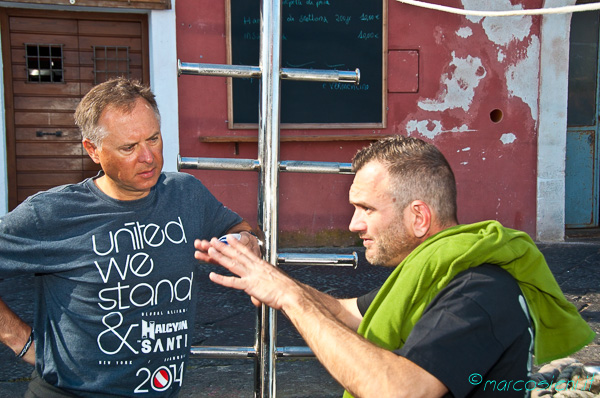
In Italia conosciamo il tuo grande marchio, ma non conosciamo il proprietario, la mente che coordina tutto, come fai tra famiglia, lavoro, fiere, Baltictech e spedizioni?
Le immersioni mi hanno attratto fin dall'infanzia, entrare in acqua senza pinne, maschera e boccaglio per me non aveva senso. Ho conseguito il mio primo brevetto di immersione nel 1991, a 16 anni, ma mi stavo immergendo già da prima. Quando sono partito con la Santi ho dovuto rallentare il ritmo, per qualche anno, l’attività e la famiglia necessitavano delle mie attenzioni. La passione si fonde con il lavoro, così non ho problemi ad alzarmi il lunedì mattina ed andare in ufficio. Quando ho iniziato a produrre mute stagne mi sono giurato che non avrei mai smesso di immergermi, dovevo mantenere l’equilibrio. Ho alcuni amici, con attività legate all’attività subacquea, che per mancanza di tempo, hanno smesso di immergersi. Ho mantenuto questa promessa, anzi sono in acqua ancora di più. Grazie alla forza di Santi possiamo supportare progetti come la ricerca del sottomarino polacco ORP Orzel e di altri relitti specialmente nel Baltico. Come co-fondatore di Baltictech sono coinvolto nel censimento dei relitti del nostro Mar Baltico e nella protezione di questo immenso patrimonio.

Tutto questo per me è speciale, è tutto collegato, e questo intreccio di passione e lavoro mi dà la forza di continuare.
Santi non solo muta stagna, perché è nata e qual è stato il segreto per la rapida crescita del marchio nel mondo
Negli anni '80 non era facile procurarsi un'attrezzatura subacquea performante, dovevi ottimizzarla da solo. Ho realizzato la mia prima muta da ritagli di neoprene. Questa muta mi ha permesso di immergermi più a lungo di prima. Affrontare le carenze del mercato era comune, se mancava qualcosa, dovevi crearlo. Mi è venuta l'idea di creare l'azienda Santi per produrre abbigliamento da lavoro. L'azienda cresceva e produceva per l'esportazione. Nel 2001 si è aperta la possibilità di fare immersioni nel Mar Baltico, e le immersioni sui relitti diventarono sempre più popolari. Da subito mi dedicai alle spedizioni subacquee. All'epoca era già possibile acquistare l'attrezzatura e le mute idonee, ma i sottomuta, però, non erano il massimo per le nostre acque fredde. Erano troppo “magri”. Santi produceva sottomuta per usi diversi. Ci accorgemmo che erano più efficaci di quelli disponibili in commercio progettati per i subacquei. Ne ho adattato uno per le mie esigenze, non sapendo che in quel momento stavo avviando la mia nuova attività. Ho regalato alcuni prototipi dei sottomuta ai miei amici subacquei, e rapidamente se ne sono diffusi i pregi. Subacquei provenienti da diverse parti del paese hanno iniziato a chiamarmi e ad ordinare quel sottomuta. Nacque così il precursore dell'odierno sottomuta BZ400.
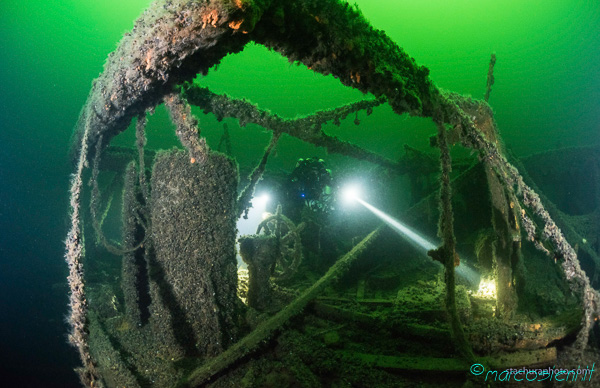
L'interesse per gli sport estremi, comprese le immersioni, ha raggiunto il suo apice nel 2003. Abbiamo deciso di dividere Santi in due società separate. L'abbigliamento da lavoro Santi è gestito da mia moglie, io gestisco Santi Diving. Il sito web ha fatto un bel lavoro ed abbiamo incrementato le vendite anche all'estero. Nel 2004 il team Santi ha avviato lo sviluppo del nuovo prodotto di muta stagna. Nuove mute sono state testate da molti subacquei in varie nazioni ed in varie condizioni climatiche. Siamo stati in grado di commercializzarla nel 2005. Sembra banale, ma una muta stagna deve rimanere asciutta, anche la più piccola perdita è inaccettabile. Le cuciamo da trilaminato, composto di tre strati. L’incollaggio ce lo siamo inventato e studiato qui in Santi. Siamo presenti ormai su quasi tutti i mercati. Da Australia, Italia, Corea, Russia, Germania, Olanda a USA, Canada e Messico. Oggi le mute stagne sono il nostro prodotto trainante. Abbiamo ottenuto risultati piuttosto buoni con mute stagne e sottomuta, ma per contrastare la concorrenza bisogna sempre progredire. Secondo questa regola abbiamo iniziato a cercare nuove soluzioni. L'azienda Santi nasce nella regione Baltica, dove non fa mai troppo caldo. Abbiamo avuto l'idea di creare un sistema di sottomuta e guanti riscaldati. Ora siamo il leader nel mercato del sistema di riscaldamento per subacquei. Il prodotto era talmente apprezzato che presto siamo stati contattati da vari enti del settore militare, dove, ora, i nostri prodotti sono molto richiesti. Siamo abbastanza soddisfatti della nostra linea Santi in commercio, ed il mercato sta crescendo molto bene in questo momento.
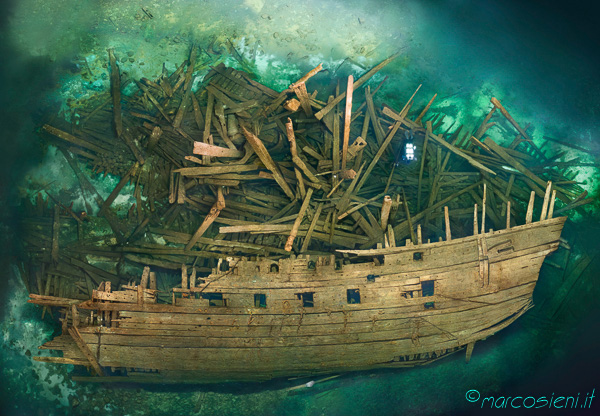
Il relitto del Mars, è stato il tuo primo grande risultato? Raccontaci qualcosa di questo incredibile scatto.
Ho avuto l'opportunità di immergermi sul Mars nel primo team che ha scoperto questo fantastico veliero, come unico subacqueo dalla Polacco. Da 456 anni giace a una profondità di 72 metri vicino all'isola Baltica di Öland e su di essa si trova un enorme tesoro. Il Mosaico del Mars è unico nel suo genere; sono state realizzate più di mille immagini a una profondità di 72 metri. Poi, in post produzione si sono unite in una unica. Le fotografie sequenziali utilizzate per realizzare la documentazione del relitto del galeone svedese Makalös Mars sono state realizzate durante diverse immersioni sui fondali del Mar Baltico e sono state scattate in condizioni estreme nel buio più totale. In una situazione del genere, è difficile ottenere precisione e ripetibilità. Le sfide incontrate per costruire un'immagine coerente sono state quelle di livellare le differenze tra immagini con diverse esposizioni derivanti dai vari angoli da cui sono state realizzate e la distorsione derivante dalla necessità di utilizzare un obiettivo grandangolare. Il mosaico è una vera e propria opera d'arte. Sebbene non rappresenti interamente l'area archeologica, mostra tutta la bellezza di questo ritrovamento. My Mosaic of Mars è apparso sulle copertine delle edizioni straniere del National Geographic. Ho scattato migliaia di foto subacquee nella mia vita, e vederne una sulla copertina di National Geographic per me è stato come arrivare in cima al Monte Everest. Ho ottenuto la mia fama di fotografo grazie a Mosaic of Mars. Fino ad allora ero solo un subacqueo dalla Polonia, poi sono diventato il ragazzo del Mars Mosaic. Ha indiscutibilmente cambiato la mia vita subacquea, ora è decisamente molto più facile organizzare molte cose. Questa notorietà mi aiuta sicuramente negli affari e nelle spedizioni.
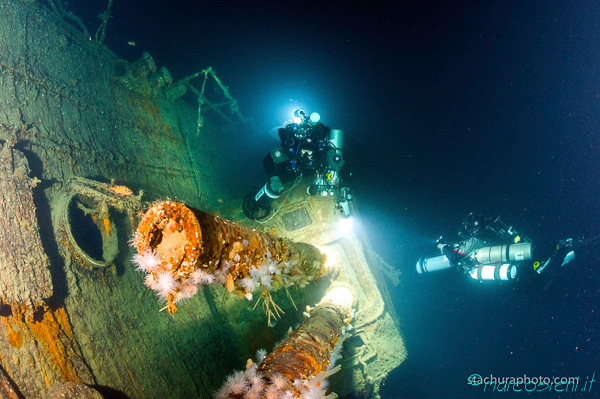
4. Karlsruhe, cosa puoi dirci?
L'unicità di questa scoperta è che era una storia abbastanza sconosciuta e uno degli ultimi misteri irrisolti della seconda guerra mondiale. Karlsruhe è stata la quarta perdita di Kriegshmarine durante l'operazione Annibale. Questa nave, completamente dimenticata, trasportava un carico piuttosto grande, la tragedia andava ricordata. Vi persero la vita 970 persone. Era più di un anno che cercavamo questo relitto. Giace ad una profondità di 88 m, 40 miglia a nord della costa Polacca nelle cosiddette acque economiche Polacche. Senza dubbio, vedendo lo stato dei reperti, siamo certi di essere stati i primi a rivederlo. L'obiettivo del team Baltictech era l'identificazione di questo relitto. Ci saremmo basati su un confronto dei dettagli costruttivi con una foto che avevamo a disposizione; tutto combaciava perfettamente. Abbiamo trovato veicoli militari, porcellane e soprattutto molte casse dal contenuto ancora sconosciuto.
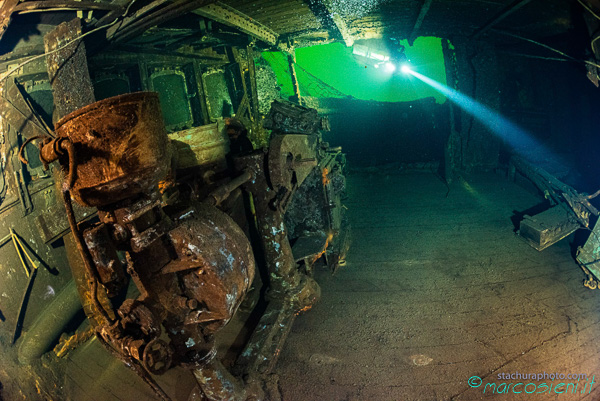
Lavorare a quella profondità è piuttosto impegnativo, il buio, ed i 4 gradi si fanno sentire. Noi subacquei non professionisti, l'abbiamo scoperto, identificato e parzialmente inventariato, ma per finire il lavoro sono necessarie enormi risorse finanziarie. Parleremo presto di questo argomento con l'Ufficio marittimo di Gdynia. Non abbiamo alcuna prova concreta che la Stanza d'Ambra sia lì, ma nessuno ha alcuna prova concreta che la Stanza d'Ambra sia altrove. Se anche solo ci fosse una probabilità dell'1% che fosse a bordo? Dobbiamo indagare a fondo. Abbiamo visto molte casse piene, perfettamente integre, grazie alla mancanza di luce e con percentuali di ossigeno bassissime, le abbiamo fotografate ma ora vanno esaminate e controllare. La verità è che i tedeschi, volendo inviare qualcosa di prezioso in Occidente, potevano farlo solo tramite Karlsruhe poiché questa era la loro ultima possibilità. L'evacuazione della Prussia orientale è stata preparata frettolosamente, non adeguatamente; la Kriegshmarine si è concentrata principalmente sull'evacuazione delle persone, non dell'attrezzatura.
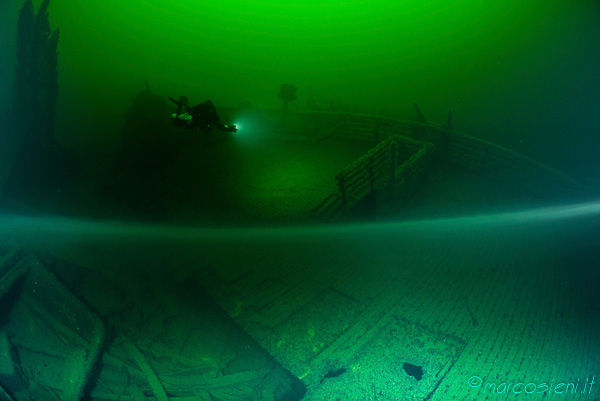
Karlsruhe si distingueva per il fatto che reggeva un carico molto grande per una nave così piccola. Fra i passeggeri si trovavano anche veicoli militari e 150 soldati della divisione Hermann Goering. Questo suscita ci sicuramente grande interesse. Ho scritto il libro "La via della morte". L'ispirazione per scriverlo è arrivata in modo molto naturale. Ho avuto l'opportunità di fotografare i più grandi disastri marittimi sul Mar Baltico, relitti come: Wilhelm Gustloff, Steuben, Goya e molti altri relitti della seconda guerra mondiale. L'intero team Baltictech si è reso conto che tutti questi relitti sono collegati in un'unica catena, una specifica via di morte. I rifugiati vennero trasportati fuori dalla Prussia orientale da est a ovest e morirono su questa rotta nel Mar Baltico. Pensa che i russi affondarono 247 navi durante l'operazione Annibale e 20.000 persone morirono in quei naufragi. Il libro “Route of Death” ripercorre queste tristi pagine di storia e racconta lo stato attuale dei relitti che presero parte a questa evacuazione.
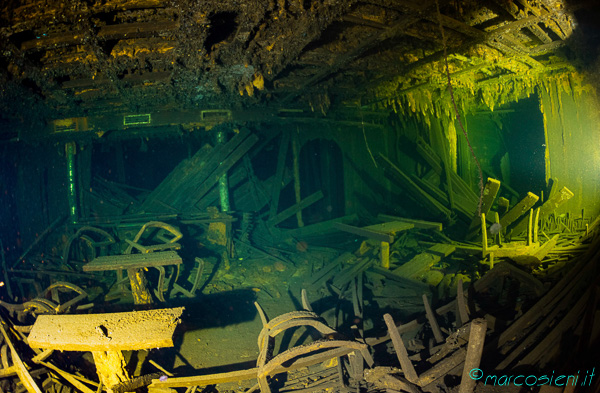
https://santionduty.com/english
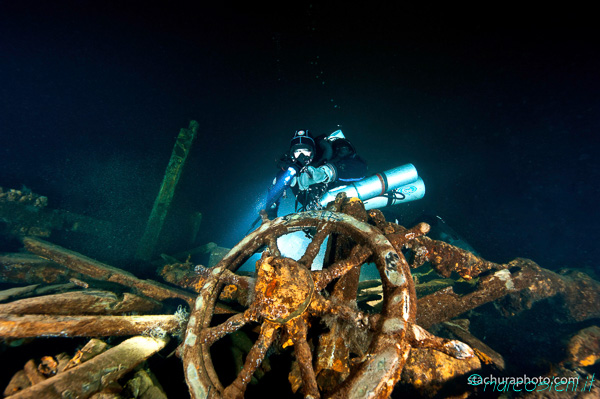
In Italy we know your great brand, but we do not know the owner, the mind that coordinates everything, how do you do it between family, work, fairs, baltictech and expeditions?
Diving has attracted me since childhood. Going into water without fins, mask and snorkel didn't make sense to me. I made my first diving certificate in 1991, when I was 16 years old, but I was diving already before. Only for a while I paused intense diving to start family and business.
I'm lucky that I combine work, passion and I don't have problems to get up to work on Monday morning. When I started producing drysuits I vowed to myself that I would never stop diving. I have some friends who got involved in diving business and then stopped diving. I was able to put this together and I dive even more. Thanks to the strength of Santi we can support projects such as the searching for the Polish submarine ‘ORP Orzel’ and other wreck especially in the Baltic Sea. As co-founder of Baltictech I am involved in the inventory of wrecks in the Baltic Sea and the protection of our heritage.
That’s all makes sense to me, is connected and this interlacing of passion and work gives me strength to act.
Santi not only dry suit, why it started and what was the secret for the fast growth of the brand in the world
In the 80s it was not easy to get a proper diving equipment, you had to organize it by yourself. I made my first wetsuit from scraps of neoprene. This wetsuit allowed me to dive longer than before. Dealing with the shortages in the market was common. If something was missing, you had to create it.
I came up with the idea to create the Santi company and produce workwear. The company was growing and producing for export. In 2001, the possibility of diving in the Baltic Sea opened up. Wreck diving was more and more popular. I returned to underwater expeditions. It was already possible to buy the right equipment and suit. In that time undersuits weren’t perfect for diving. They were too thin. Santi was producing undersuits to different destinies. It turned out that they are better than these available on the market designed for divers. I adapted one of them for my needs. At that time, I didn’t know that it would become my new business. I also gave such special undersuits to my diving friends. It’s quickly spread, amateur divers from different parts of the country began to call me and order undersuits. This is how the prototype of today's BZ400 undersuit was created.
Interest in extreme sports, including diving, reached its apogee in 2003. We decided to split Santi into two separate companies. Santi workwear is run by my wife, I manage Santi Diving. Website did its job and new orders came from abroad. In 2004 Santi team initiated development of the new drysuit product. New suits were tested by many divers. We were able to introduce it to the market in 2005. A drysuit must stay dry, even the smallest leak disqualifies it. We sew it from trilaminate, consisting of three layers. The way of gluing we invented here in Santi. Santi is present on almost every market now. From Australia, Italy Korea, Russia, Germany, Holland to USA, Canada and Mexico. Today drysuit is our main product.
We achieved quite good results through producing drysuits and undersuits, but if the company ceases to develop and stands still is doomed to failure. According to this rule we started to look for new solutions. The Santi company comes from the Baltic region, where it is never too warm. We came up with the idea to create a heating system. Now we are the market leader of underwater heating system for divers.
It was also very natural for us to enter the military market, where our products are highly needed. The Santi on duty line is growing very well right now.
Mars wreck, it was your first great result? Tell us something about this incredible shot.
I had the opportunity to dive to Mars in the first team inventorying this amazing sailing ship, as the only diver from Poland. For 456 years it has been lying at a depth of 72 meters near the Baltic island of Öland and there is a huge treasure on it.
The Mosaic of Mars is unique in its form - over a thousand pictures was made at a depth of 72 meters. Then came their assembly into a single image. Sequential photographs used to make the compilation of the Swedish galleon wreck Makalös Mars were made during several dives on the Baltic seabed and were shot in extreme conditions in total darkness. In such a situation, it is difficult to achieve precision and repeatability. The challenges met in order to build a coherent picture were those of leveling the differences between images with different exposures arising from various angles from which they were made, and the distortion resulting from the need to use a wide angle lens. The mosaic is a kind of work of art. Although it is not entirely depicting the archaeological area, it shows its beauty.
My Mosaic of Mars appeared on the covers of foreign editions of National Geographic. I have taken thousands of underwater pictures in my life, so see one of them on the cover of National Geographic for me is like getting to the top of the Mount Everest.
I became a well known photographer because of Mosaic of Mars and its publication on the covers of National Geographic in different countries around the world. Until then I was just a diver from Poland, then I became a guy of the Mars Mosaic. It definitely changed my diving life. It is much easier to organize many things. This recognition certainly helps me in business and passion.
4. Karlsruhe, what can you tell us?
The uniqueness of this discovery was that it was a quite an unknown story and one of the last unresolved mysteries of the Second World War. Karlsruhe was Kriegshmarine's fourth loss during Operation Hannibal. She carried quite a largeload and was an utterly submerged story, and it is definitely worth mentioning. 970 people lost their lives there.
We had been looking for this wreck over a year. The wreck rests at a depth of 88 m, 40 miles north of the Polish coast in so-called Polish economic waters. Diving the wreck, we are certain that we got there first. The aim of Baltictech team was wreck identification. It was based on a comparison of construction details with a photo of the original we have at our disposal, and everything was exactly the same. We discovered military vehicles, porcelain in the holds and also many crates with as yet unknown contents.
Working at this depth is very complicated. We, as amateur divers have discovered it, identified it and partially inventoried it. To continue the work there, enormous financial resources are needed. We will be discussing this subject with the Maritime Office in Gdynia, Poland soon.
We do not have any hard evidence that the Amber Room is there, but nobody has any hard evidence that Amber Room is elsewhere. We give a 1% chance that it is there. The difference is that we have seen crates with some sort of load, we have them photographed and all we have to do is look into them and check. The truth is that the Germans, wanting to send something valuable to the West, could only do it by means of Karlsruhe as this was their last chance, and it is worth knowing that the evacuation of East Prussia was not prepared fully properly and Kriegshmarine focused mostly on evacuating people, not the equipment. Karlsruhe was distinguished by the fact that she held a large load as for such a small ship. Besides, she carried vehicles and 150 soldiers from Hermann Goering division. This certainly arouses great interest.
I wrote the “Route of Death” book. The inspiration to write it was born in the most natural way. I had an opportunity to photograph the biggest maritime disasters on the Baltic Sea, wrecks such as: Wilhelm Gustloff, Steuben, Goya and many other metal wrecks from the Second World War. The whole Baltictech team realized that all these wrecks are connected in one chain, a specific route of death. The refugees were transported out of East Prussia from the east to the west and died in the Baltic Sea. It should be remembered that the Russians sank 247 ships during Operation Hannibal and 20,000 people died on those ships. The “Route of Death” book describes the whole story in a very brief way and shows the current state of the shipwrecks that took part in this evacuation.
https://santionduty.com/english
MS 12/21